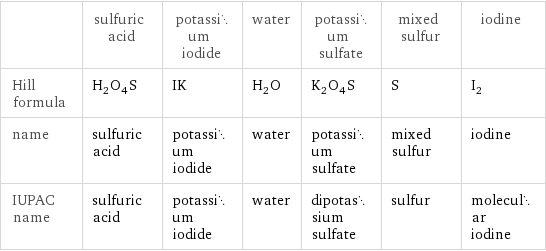Input interpretation

sulfuric acid + potassium iodide ⟶ water + potassium sulfate + mixed sulfur + iodine
Balanced equation

Balance the chemical equation algebraically: + ⟶ + + + Add stoichiometric coefficients, c_i, to the reactants and products: c_1 + c_2 ⟶ c_3 + c_4 + c_5 + c_6 Set the number of atoms in the reactants equal to the number of atoms in the products for H, O, S, I and K: H: | 2 c_1 = 2 c_3 O: | 4 c_1 = c_3 + 4 c_4 S: | c_1 = c_4 + c_5 I: | c_2 = 2 c_6 K: | c_2 = 2 c_4 Since the coefficients are relative quantities and underdetermined, choose a coefficient to set arbitrarily. To keep the coefficients small, the arbitrary value is ordinarily one. For instance, set c_5 = 1 and solve the system of equations for the remaining coefficients: c_1 = 4 c_2 = 6 c_3 = 4 c_4 = 3 c_5 = 1 c_6 = 3 Substitute the coefficients into the chemical reaction to obtain the balanced equation: Answer: | | 4 + 6 ⟶ 4 + 3 + + 3
Structures

+ ⟶ + + +
Names

sulfuric acid + potassium iodide ⟶ water + potassium sulfate + mixed sulfur + iodine
Equilibrium constant
![K_c = ([H2O]^4 [K2SO4]^3 [S] [I2]^3)/([H2SO4]^4 [KI]^6)](../image_source/55c2b0d55813f080237b57a86001a0f4.png)
K_c = ([H2O]^4 [K2SO4]^3 [S] [I2]^3)/([H2SO4]^4 [KI]^6)
Rate of reaction
![rate = -1/4 (Δ[H2SO4])/(Δt) = -1/6 (Δ[KI])/(Δt) = 1/4 (Δ[H2O])/(Δt) = 1/3 (Δ[K2SO4])/(Δt) = (Δ[S])/(Δt) = 1/3 (Δ[I2])/(Δt) (assuming constant volume and no accumulation of intermediates or side products)](../image_source/fa4015d86715c748b6651ec46821d045.png)
rate = -1/4 (Δ[H2SO4])/(Δt) = -1/6 (Δ[KI])/(Δt) = 1/4 (Δ[H2O])/(Δt) = 1/3 (Δ[K2SO4])/(Δt) = (Δ[S])/(Δt) = 1/3 (Δ[I2])/(Δt) (assuming constant volume and no accumulation of intermediates or side products)
Chemical names and formulas

| sulfuric acid | potassium iodide | water | potassium sulfate | mixed sulfur | iodine Hill formula | H_2O_4S | IK | H_2O | K_2O_4S | S | I_2 name | sulfuric acid | potassium iodide | water | potassium sulfate | mixed sulfur | iodine IUPAC name | sulfuric acid | potassium iodide | water | dipotassium sulfate | sulfur | molecular iodine